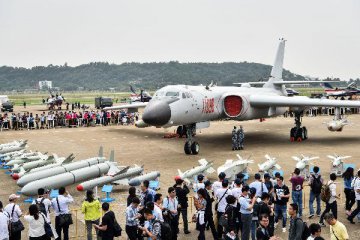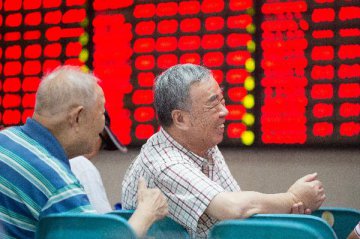
China will implement major science and technology projects during the 13th Five-Year Plan period, to continue to promote the development of high-end equipment manufacturing industry and fully launch the special projects on aircraft and gas turbine engines (“two engines”), said Miao Yu, head of the Ministry of Industry and Information Technology (MIIT), at the national conference of industry and information technology innovation on Nov. 24.
Various policies aimed at supporting high-end equipment manufacturing industry have been introduced since the beginning of the year. With such policy support, the formation of five high-end equipment manufacturing industrial belts is accelerating. The industry insiders estimated that after the implementation of subsequent policies and measures, high-end equipment manufacturing industry will see development opportunities during the 13th Five-Year Plan period.
Policy prop-up for special projects on two engines
As major science and technology projects that have been approved by the authority, the development of aircraft and gas turbine engine projects are highlights in the market. Miao said that China will fully launch special projects on these two engines during the 13th Five-Year Plan period, striving to make breakthroughs in key technologies, promote the research and manufacturing of large aircraft engine, advanced helicopter engine and heavy duty gas turbine, and preliminarily establish fundamental research, technology and product R&D and industrial systems for the self-dependent innovation of the two engines.
The Economic Information Daily learnt from various authoritative channels that key emphases in work of the special projects on the two engines have already been determined. As to aircraft engine project, the highlights are turbofan and turbojet engines, as well as vortex axis, turboprop and piston engines which also have demand in the market. The focus is research of key products such as large turbofan engine, small and medium turbofan/ vortex jet engine and medium-high power turboshaft engines. As for gas turbine project, the goal is to realize self-independent research and manufacturing of F-grade 300MW gas turbine by 2020 and H-grade 400MW gas turbine by 2030.
As it involves a number of manufacturing fields and there are great demands from both domestic and global markets, the aircraft and gas turbine engine industry occupy a decisive position in global manufacturing industry. The national manufacturing power construction strategy advisory committee predicted in a report that the global market has strong demand for aircraft engine products in the next decade. The total global demand for turbofan and turbojet engines, turboshaft engine, turboprop engine and piston engine are expected to reach over 73,600 sets, 34,000 sets, 16,000 sets and 33,000 sets respectively, representing total value of 400 billion dollars, 19 billion dollars, 15 billion dollars and 3 billion dollars.
Gas turbines are widely used in electricity, shipping and manufacturing industries, especially the energy and power industry. According to estimations of various third-party institutions, the global demand for the energy and power industry alone amounts to 500 billion dollars. When taking into account of demands from the shipping and manufacturing industries, the overall market size is expected to reach trillions of dollars.
China Merchants Securities pointed out in a securities research report that the China’s aircraft engine and gas turbine engine industries will accelerate the development pace after the launch of the two engine special projects, and are expected to enter the global market and break monopoly by giants in the industry. In addition, as the aircraft engine and gas turbine engine industries grow bigger and stronger, it will further enhance the overall competitiveness of China’s high-end manufacturing industry in the world, and expedite the access of other products such as big commercial aircrafts, electrical equipment and ships into the international market.
Impact: push “Made-in-China” to higher level
Since the beginning of the year, various policies supporting the high-end equipment manufacturing industry have been launched in succession, which created an ideal environment for industrial development. During the “two sessions” earlier this year, the outline of the 13th Five-Year plan expressly pointed out that China will implement high-end equipment innovation development projects in the next five years, and focus on eight industries, including the aerospace, rail transit and oceaneering industries. Subsequently, the MIIT, the National Development and Reform Commission (NDRC) and the Ministry of Finance (MOF) successively issued Implementation Plans on Special Action of Green Manufacturing 2016, Notice on Launching Special Action to Build a More Solid Foundation for Industry Development and Development Plan on the Robot Industry (2016-2020), and started the collection of major projects for Made-in-China 2025, as well as selection of major special projects for high-end equipment manufacturing sectors such as aerospace and shipping.
As China’s industry transformation and upgrading entered a critic stage, to develop high-end equipment manufacturing industry becomes increasingly important. Research of the national manufacturing power construction strategy advisory committee shows that sales revenue of China’s high-end equipment manufacturing exceeded 6 trillion yuan in 2015, representing about 15 percent of the whole equipment manufacturing industry. It is estimated that this proportion will be increased to 25 percent by 2020. The high-end equipment manufacturing industry is expected to become a pillar of national economy.
Data shows that the output of China’s equipment manufacturing industry has exceeded 2 trillion yuan earlier in 2013, accounting for one third of the global output. Despite the size of the industry is big, but it is not that strong. Coupled with weak independent innovation capability, China’s high-end equipment manufacturing industry still falls behind developed European countries and the U.S.
The launch of various policies with further consolidate the development of China’s high-end equipment manufacturing industry, and promote the development of the equipment manufacturing industry and the whole manufacturing industry, Jiang Hongde, academician of the Chinese Academy of engineering, told the Economic Information Daily. “The difficulty of R&D in high-end equipment manufacturing industry is far beyond ordinary industries. Therefore, policy support is extremely important for the development of the industry. With the introduction of relevant policies and release of policy drive, the high-end equipment manufacturing industry is expected to maintain strong momentum in the 13the Five-Year Plan period.”
China will release a series of policies and measures in the future to further promote the sound development of high-end equipment manufacturing industry, journalist learnt from MIIT, NDRC, and other authorities. The “13th Five-Year Plan” for Strategic & Emerging Industries, which is likely to issue at the end of this year, will focus on the 13th Five-Year Plan development for railway transportation, marine engineering, aviation & aerospace, and other high-end equipment manufacturing industries, and sketch a development blueprint for them in next five years. Additionally, National Manufacturing Strategy Advisory Committee plans to release new version of technical roadmap for key sectors under the strategy of Made in China 2025 in next year. The said roadmap will guide the development of high-end equipment manufacturing industries to guarantee their technical advance.
Integration: formation of several industrial zones speeds up
Incented by policies, China’s high-end equipment manufacturing industries gain favorable development trend; with constantly-improved technologies and continuously-emerged key products, several industrial zones for high-end equipment manufacturing industries also speed up to form.
Related authorities are preparing and formulating the development and planning scheme for the said zones based on deployment of the State Council, journalist learnt. This plan will promote the comprehensive development of aviation, ship, automobile, railway transportation, and other high-end equipment manufacturing industries in different regions based on the existing advantages for manufacturing, so as to enhance the industrial zones centralized in core cities and regions to this respect.
According to arrangement by the State Council, NDRC, MIIT, China Academy of Engineering, and other authorities & organizations have already carried out pre-planning for the development of said industrial zones, the MIIT told the journalist. Now, China has formed several core-city groups based on cities, such as Beijing, Tianjin, Shanghai, Guangzhou, Zhuhai, Shenzhen, Changsha, Wuhan, Xi’an, Chengdu and Chongqing, and also provinces, like Shandong, Jiangsu, and Zhejiang. In order to make industries in these cities and provinces play their role, China will continue to create a series of high-end equipment manufacturing industrial zones based on the existing advantages of manufacturing in each region during the 13th Five-Year Plan period, and form several industrial groups, like nuclear power, new energy automobile, marine engineering, and other sectors based on the existing industries of aviation, ship and automobile.
The survey and formulation work has been initiated firstly for the development and planning of high-end equipment manufacturing industrial zones in South Jiangsu and Zhejiang according to the work plan of related authorities, and the work for other regions will also be carried out one by one, it learnt. Strength will focus on development of aviation, ship, automobile, marine engineering, smart equipment manufacturing, new energy automobile, and other industries based on the existing status of manufacturing industries in the said two big regions.
“Five high-end equipment manufacturing industrial zones are likely to form in the 13th Five-Year Plan period through a way that core urban zones incent regional development, including Bohai Costal Region based Beijing, Tianjin and Shandong, Yangtze River Delta region based on Shanghai, Jiangsu and Zhejiang, Pearl River Delta region based on Guangzhou, Zhuhai and Shenzhen, Central Region based on Hunan and Hubei provinces, as well as Western Region based on Shanxi, Sichuan provinces and Chongqing”, related insider told the journalist.
Translated by Adam Zhang and Jelly Yi





















Latest comments